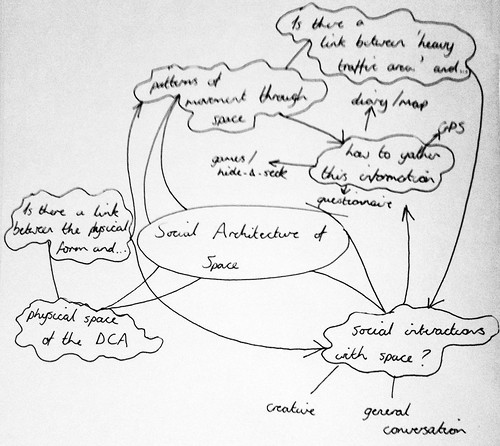I'm now almost a month in to my day-a-week placement with SerenA, based in the VRC. It has been, challenging, to say the least. My understanding of space syntax is a little further forward, despite the complexities surrounding the theory. I find myself struggling more and more to describe space syntax beyond a rudimentary understanding of the term itself for fear of misrepresenting the theories behind it. This makes it even more difficult to apply it to my own data collection, as, I'm not sure what information I'm looking for use with space syntax. So, I'm taking a step back and attempting to develop my own methodologies for data collection, that may or may not be similar to those used in space syntax theory.
I've got to continually remind my self of the main focus, which is to "map" the social interactions within the VRC and by extension the DCA. Even this is more complex than it may sound. The ambiguity of the term "social interactions", needs refining, for example, giving certain importance to different types interaction, from the banal "Hello, how are you?" to a conversation that influences your work.
Speaking of conversations that influence my work. I have begun to speak with those who work/ study in the VRC day-to-day, and this further highlights the complex relationship "users" have internally with the space, and beyond this, the, as yet, undefined (in my opinion), relationship between the VRC and DCA. People create a minefield of various factors which effect space use, and by extension, social interaction. So, how do I move forward?
Keep it simple. During March I plan to run a few studies intended to collect data I wish to use. One thing, I can't get out of my head right now, is hide-and-seek, discussed by Hillier and Hanson (1984) which brings together the arrangement of space and the individual. In describing hide-and-seek, they explain: "the head predominates over the physical structure of the environment, which it uses actively and creatively."
There's something in this that I want to use, something I don't fully understand. I think, on a basic level, I like the notion of random exploration of space for the purpose of hiding. What would a map of hiding places in the VRC look like? Would it correlate with areas under-utilised? I'm not sure, but it's an idea I intend to refine.
Other studies I am considering for the VRC, and perhaps the DCA, are (but not limited to):-
- Diary maps - capturing social interactions.
- Observation of movement within space - in person, and via CCTV.
- Get a game of hide-and-seek.
I'm almost deliberately out of my depth with the project, and that's what makes it so challenging and interesting. Once I've formulated a more rigid programme of surveys I will update.

No comments:
Post a Comment